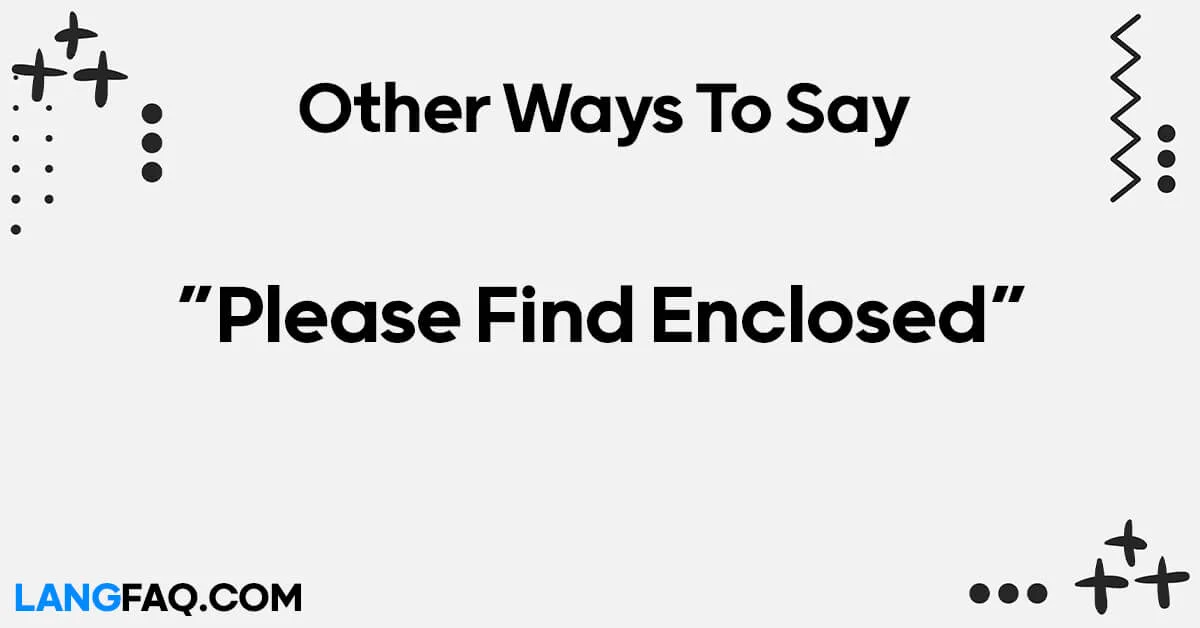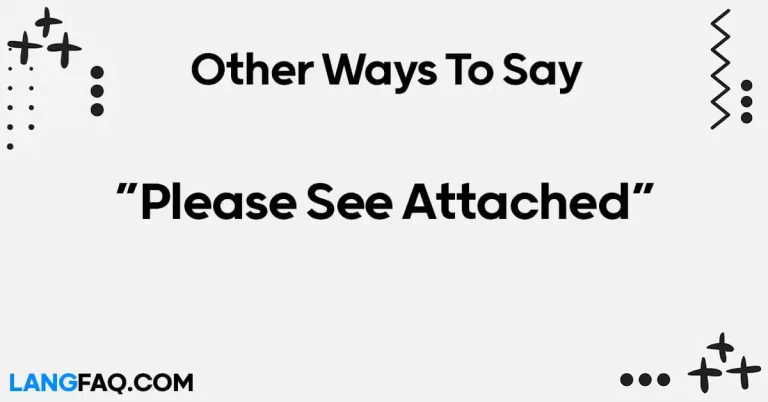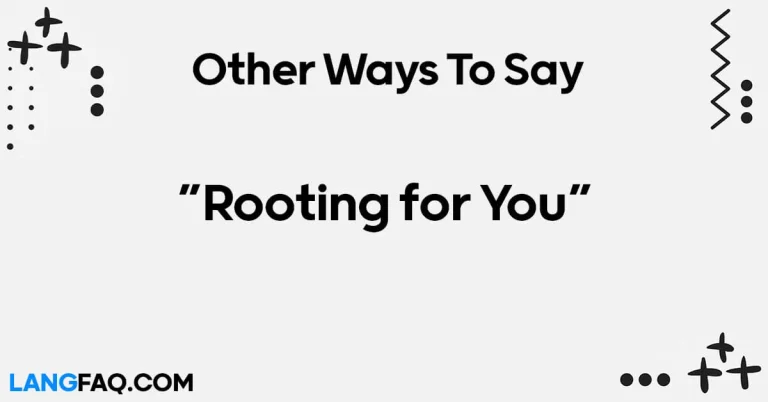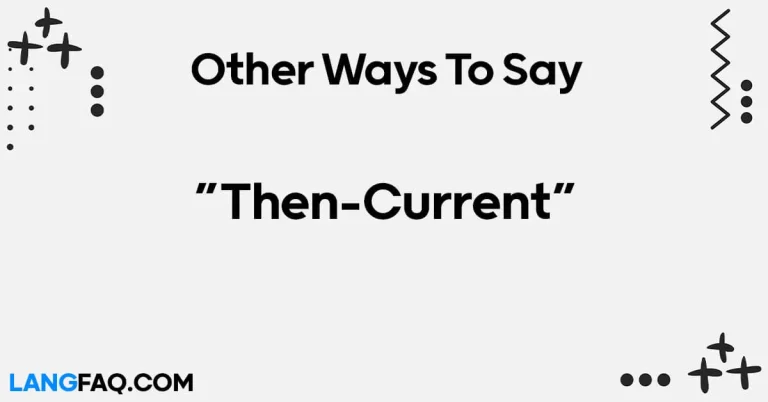In the realm of professional correspondence, the phrase “Please Find Enclosed” has been a stalwart companion. However, the world of language is vast and varied, offering a myriad of alternatives that can enhance your written communication. This article explores 12 other ways to express the act of enclosing documents, providing a rich tapestry of language for various contexts.
12 Other Ways to Say “Please Find Enclosed”
Here are 12 alternative ways to say “Please Find Enclosed”:
- Attached, Please Find
- Enclosed, You Will Discover
- Here Is the Enclosed
- I Am Attaching
- Enclosed for Your Review
- Included Is
- This Email Contains
- Kindly See the Attached
- Enclosed Herein Are
- Enclosed Please See
- Attached for Your Reference
- I Have Enclosed
Here’s a table with meanings and examples for the 12 alternative ways to say “Please Find Enclosed”:
| Expression | Meaning | Example |
|---|---|---|
| Attached, Please Find | Indicates the presence of enclosed documents or materials. | Attached, please find the report for your review. |
| Enclosed, You Will Discover | Emphasizes the act of finding or coming across the enclosed items. | Enclosed, you will discover the necessary forms. |
| Here Is the Enclosed | Directly states the presence of attached documents. | Here is the enclosed contract for your signature. |
| I Am Attaching | Explicitly states the action of attaching files or documents. | I am attaching the requested files for your perusal. |
| Enclosed for Your Review | Highlights the purpose of the attachment for careful examination. | Enclosed for your review is the revised proposal. |
| Included Is | Mentions that the attached materials are included with the message. | Included is the schedule for next week’s meeting. |
| This Email Contains | Specifies that the email itself holds relevant attachments. | This email contains the necessary forms for completion. |
| Kindly See the Attached | Politely directs attention to the enclosed documents. | Kindly see the attached invoice for your records. |
| Enclosed Herein Are | Formally indicates the presence of documents within the message. | Enclosed herein are the requested certificates. |
| Enclosed Please See | Requests the recipient to examine the enclosed items. | Enclosed, please see the detailed project plan. |
| Attached for Your Reference | Specifies that the attachment is for the recipient’s reference. | Attached for your reference is the product catalog. |
| I Have Enclosed | Directly states the action of enclosing documents in the message. | I have enclosed the contract for your signature. |
This diverse array of expressions provides you with versatile alternatives to convey the presence of enclosed documents. Whether you’re aiming for formality, clarity, or a touch of politeness, these phrases offer flexibility to enhance your communication. By incorporating these alternatives, you can tailor your language to various situations, adding richness and precision to your written correspondence.
Is It Correct to Say “Please Find Enclosed”?
Yes, the phrase “Please find enclosed” is grammatically correct and commonly used in business and formal communication. It is a polite and standard way to inform the recipient that there are documents or materials included with the message.
Usage and Context:
- Professional Correspondence: In formal business emails, letters, or any communication where a certain level of formality is expected, “Please find enclosed” is appropriate. It is often used when sending attachments, such as reports, contracts, or other documents.
Example in Email:
Dear [Recipient],
Please find enclosed the finalized version of the project proposal for your review.
Best regards, [Your Name]
Variations:
- “Attached please find”
- “Enclosed, please find”
- “Kindly find attached”
When to Use:
- Attachments: Use this phrase when you want to draw attention to the fact that the email includes specific documents or materials.
- Formal Communication: It is suitable for professional settings, especially in business emails, where maintaining a formal tone is important.
Pros:
- Politeness: The phrase is courteous and demonstrates a level of professionalism.
- Clarity: It clearly indicates that there are attachments for the recipient to review.
Cons:
- Formality: In more casual or informal settings, the phrase might come across as overly formal. In such cases, alternatives like “I’ve attached” or “Here is” could be more suitable.
Grammar Insight: The phrase follows a standard grammatical structure and is widely accepted in business communication. However, for a slightly more modern and concise approach, consider using variations like “Attached please find” or “I have attached.”
In conclusion, “Please find enclosed” is correct and appropriate for formal communication, especially when you want to convey the inclusion of attachments in a polite manner. Adapt the phrase based on the specific context and level of formality required for your communication.
Professional Mail Example With “Please Find Enclosed”
Below is an example of a professional email using the phrase “Please find enclosed”:
Subject: Finalized Report for Q4 Review
Dear [Recipient’s Name],
I trust this email finds you well. As we approach the end of the quarter, I am pleased to share with you the finalized report summarizing our team’s achievements and key metrics for Q4.
Please find enclosed the comprehensive report, detailing the progress made in various projects, financial updates, and upcoming initiatives. Your insights and feedback on this document are invaluable, and I appreciate your time in reviewing it.
If you have any questions or require further clarification on specific sections, please do not hesitate to reach out. I am available for a discussion at your earliest convenience.
Thank you for your continued dedication to our team’s success. I look forward to hearing your thoughts on the report.
Best regards,
[Your Full Name] [Your Position] [Your Company] [Contact Information]
1. Attached, Please Find
Meaning: This phrase implies that the recipient will discover attached documents or materials upon opening the message.
Usage: In formal contexts like business emails or professional correspondence, use “Attached, please find” to maintain a polite tone while directing attention to the enclosed items.
Example:
Dear [Recipient],
Attached, please find the finalized proposal for your review.
Best regards, [Your Name]
Variations:
- Enclosed, please find
- Kindly find attached
Grammar Insight: When using this phrase, ensure that the attached documents are easily accessible and clearly labeled for the recipient.
2. Enclosed, You Will Discover
Meaning: Emphasizing the act of discovering, this phrase subtly guides the reader to explore the enclosed items.
Usage: Ideal for formal emails or documents requiring a sophisticated touch, “Enclosed, you will discover” adds a hint of curiosity to your message.
Example:
Dear [Recipient],
Enclosed, you will discover the latest market analysis report.
Warm regards, [Your Name]
Variations:
- Enclosed, you will find
- Enclosed, you’ll discover
Dictionary Insight: The use of “discover” in this context suggests a deliberate act of finding, adding a layer of engagement to your communication.
3. Here Is the Enclosed
Meaning: Directly states the presence of attached documents, offering a straightforward approach.
Usage: In both formal and informal settings, “Here is the enclosed” provides clarity without excessive formality.
Example:
Hi [Recipient],
Here is the enclosed schedule for our upcoming meeting.
Best, [Your Name]
Variations:
- Here’s the enclosed
- This is the enclosed
Grammar Insight: Ensure the phrase is followed by a clear and concise description of the enclosed items to maintain transparency.
4. I Am Attaching
Meaning: Explicitly states the action of attaching files or documents to the message.
Usage: Suitable for professional emails and situations where directness is appreciated, “I am attaching” conveys a proactive approach.
Example:
Dear [Recipient],
I am attaching the quarterly financial report for your review.
Regards, [Your Name]
Variations:
- I have attached
- Attached are
Dictionary Insight: The use of “am attaching” emphasizes the ongoing action, signifying immediacy and responsiveness.
5. Enclosed for Your Review
Meaning: Merges formality with a suggestion to thoroughly examine the materials.
Usage: Common in business communication, “Enclosed for your review” invites a detailed inspection of the attached documents.
Example:
Hello [Recipient],
Enclosed for your review are the proposed project timelines.
Sincerely, [Your Name]
Variations:
- For your review, enclosed are
- Attached for your consideration
Grammar Insight: Use this phrase when you want the recipient to critically evaluate the enclosed content, often in professional or academic contexts.
6. Included Is
Meaning: Mentions that the attached materials are included with the message.
Usage: Versatile in both formal and informal settings, “Included is” provides a straightforward way to indicate the presence of enclosed items.
Example:
Hi [Recipient],
Included is the agenda for our upcoming team meeting.
Best, [Your Name]
Variations:
- Attached is
- Here’s what’s included
Dictionary Insight: The use of “included” emphasizes the encompassing nature of the attached materials, promoting a sense of completeness.
7. This Email Contains
Meaning: Specifies that the email itself holds relevant attachments.
Usage: Modern and straightforward, “This email contains” is suitable for various contexts, from business to casual communication.
Example:
Dear [Recipient],
This email contains the necessary forms for your upcoming presentation.
Best, [Your Name]
Variations:
- Included in this email is
- Here’s what this email contains
Grammar Insight: Use this phrase when you want to draw attention to the fact that all relevant information is contained within the email itself.
8. Kindly See the Attached
Meaning: Politely directs attention to the enclosed documents.
Usage: In formal emails where a touch of politeness is desired, “Kindly see the attached” strikes a balance between formality and friendliness.
Example:
Hello [Recipient],
Kindly see the attached project proposal for your consideration.
Warm regards, [Your Name]
Variations:
- Please see the attached
- Your attention is kindly requested for the attached
Dictionary Insight: The use of “kindly” adds a courteous tone to the request, aligning well with professional communication norms.
9. Enclosed Herein Are
Meaning: Formally indicates the presence of documents within the message.
Usage: Suitable for legal or official contexts, “Enclosed herein are” adds a formal touch to your communication.
Example:
Dear [Recipient],
Enclosed herein are the signed contracts for the upcoming project.
Sincerely, [Your Name]
Variations:
- Herein are enclosed
- Enclosed herein you’ll find
Grammar Insight: “Herein” is a more formal alternative to “here,” contributing to a legal or authoritative tone.
10. Enclosed Please See
Meaning: Requests the recipient to examine the enclosed items.
Usage: In situations where you want the recipient to pay specific attention to the enclosed content, “Enclosed please see” is effective.
Example:
Hi [Recipient],
Enclosed, please see the detailed project plan for our upcoming initiative.
Best, [Your Name]
Variations:
- Please see enclosed
- Attached, please see
Dictionary Insight: The use of “please see” emphasizes the expectation that the recipient will take notice of the enclosed content.
11. Attached for Your Reference
Meaning: Specifies that the attachment is for the recipient’s reference.
Usage: Ideal for situations where the recipient may need to refer back to the attached materials, “Attached for your reference” is both polite and informative.
Example:
Hello [Recipient],
Attached for your reference is the client history document.
Best regards, [Your Name]
Variations:
- For your reference, attached is
- Attached herewith for your reference
Grammar Insight: Use this phrase when you want to emphasize the informational nature of the enclosed documents for the recipient’s future use.
12. I Have Enclosed
Meaning: Directly states the action of enclosing documents in the message.
Usage: In a straightforward manner, “I have enclosed” is suitable for various contexts, offering a clear indication of attached materials.
Example:
Dear [Recipient],
I have enclosed the requested files for your review.
Sincerely, [Your Name]
Variations:
- Enclosed are
- Here are the enclosed documents
Dictionary Insight: The use of “have enclosed” conveys a sense of completion and initiative, highlighting your proactive approach in providing the necessary information.
FAQs
Q: Are these alternatives suitable for formal business communication? Yes, many of these alternatives are suitable for formal contexts. Choose expressions based on the level of formality required in your correspondence.
Q: Can I use these phrases in academic writing? While some alternatives are more casual, others can be adapted for academic use. Consider the tone appropriate for your context.
Q: How do I avoid sounding repetitive in professional emails? Rotate between different expressions to maintain variety and professionalism in your communication.
Q: Is it essential to mention enclosed documents explicitly? Yes, clarity is key in professional communication. Ensure your reader knows to expect attached materials.
Q: Are there cultural considerations when using these alternatives internationally? Absolutely. Some expressions may be more widely accepted in certain regions, so tailor your choices based on cultural nuances.
Q: Can I use these alternatives in handwritten letters? Certainly. While some are more commonly associated with emails, many alternatives can seamlessly transition to handwritten correspondence.







